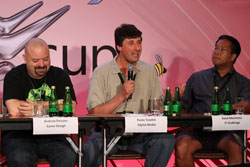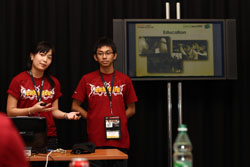WARSAW, Poland – July 4, 2010 – Diogo Romero Burgos do Nascimento was too busy fiddling with his laptop to notice an Imagine Cup official enter the cramped presentation room.

Brazil team member Diogo Romero Burgos do Nascimento presents Team T.M.D.’s Recycle-Box project at the Imagine Cup World Finals.Warsaw, Poland, July 4, 2010.
“Brazil team, are you guys ready? Judges will be here in two minutes.”
Burgos do Nascimento looked up, paused, and then exhaled.
“Yes,” he said.
As the judges entered and a small cadre of international press looked on, the nervous Brazilian student circled the presentation table once and rubbed his hands together. Moment later, a large clock next to him started to tick off his 10 minutes. “Let’s imagine a world where technology can solve the world’s largest problems,” he began.
For the next nine minutes and 30 seconds on Sunday, July 4, Burgos do Nascimento described his team’s Recycle-Box project as he made his case before the judges deciding if Team T.M.D. would advance to the next round of the Imagine Cup’s embedded development contest. Similar displays of nerves were playing out in presentation rooms across Warsaw’s Palace of Culture as competition got underway at the 2010 Imagine Cup World Finals. Now through July 8, 400 students at the Imagine Cup will be competing for cash prizes totaling approximately $240,000 across five competition categories and six awards.
After his presentation, Brazil’s Burgos do Nascimento admitted he had been a little nervous. “It’s good to be out of the presentation room,” he said. But he expressed confidence he would have another chance to make his case. “We’re here to win.”
Meanwhile, all 113 teams gathered in Warsaw for the Imagine Cup spent parts of their Sunday setting up their project presentations in display booths in advance of a Monday presentation day for the press. In front of his team’s booth, Romania’s Andrei Cantea was getting a massage from teammate Alina Calin to help calm his nerves.
It was the team’s first international competition, he explained. They were nervous, but they also were eager to discuss their project with passersby. Called Caregamer, their project is a web application that leverages the worldwide popularity of video games to solve some of world’s toughest problems, Cantea said. Players visiting the Caregamer site can raise money for their preferred causes by playing a video game and earning points. Based on the number of points raised, a percentage of all advertising funds raised by the site will be donated to charity.
Like many other groups competing at the Imagine Cup, Team Simplex already has its project up and running in the “real world.” The Caregamer site has already attracted “a serious amount of advertisers,” including a famous one from Transylvania. “We have funds from Dracula himself,” Cantea quipped.
The team said that they hope to do well at the Imagine Cup, but winning wasn’t the most important thing. “When we came up

Imagine Cup Captain Paolo Tosolini speaks at a press conference at the Imagine Cup Finals. Seated next to him are Captains Andrew Parsons (L) and Rand Morimoto (R). Warsaw, Poland, July 4, 2010.
with the idea, we wanted to use it and enter the Imagine Cup,” Cantea said. “After developing it and seeing how it could do some good, we thought it would be great if we could come here and get attention.”
Win or lose, the Imagine Cup is not the end but the beginning for Caregamer, he added.
Thailand’s Team SuperLove Factory expressed the same sentiment. Shining a light on the problems it tackles is what’s most important to the team. “We need to spread the love to the blind people,” said Sruit Angkavanitsuk.
The team’s entry for the embedded development contest is called the Braille Eye Project. Using various input devices such as a camera, the project that lets blind individuals visualize the world around them by touching and feeling a generated “simulation image.”

Jootharphim Pongschatmane (left) and Suthat Rongraung of Team SuperLove Factory present their Braille Eye Project at the Imagine Cup World Finals in Warsaw, Poland. July 4, 2010.
The idea behind SuperLove Factory’s project came out of Angkavanitsuk’s experience volunteering at a blind school, which he’s done for the past three years. “When the students asked me, ‘Am I beautiful?’ I cannot answer them. So I started thinking about this project.”
The Thai students weren’t nervous, they said, but they were sleepy; they had practiced and polished their presentation until 4 a.m. the night before. And like Romania’s Team Simplex, they would rather raise awareness for their project and its potential impact.
“When we finish here at the Imagine Cup, maybe our idea can go out into world,” said Suthat Rongraung. “It could be the begging of the idea that the blind can see.”
Follow all the action at the 2010 Imagine Cup World Finals.




